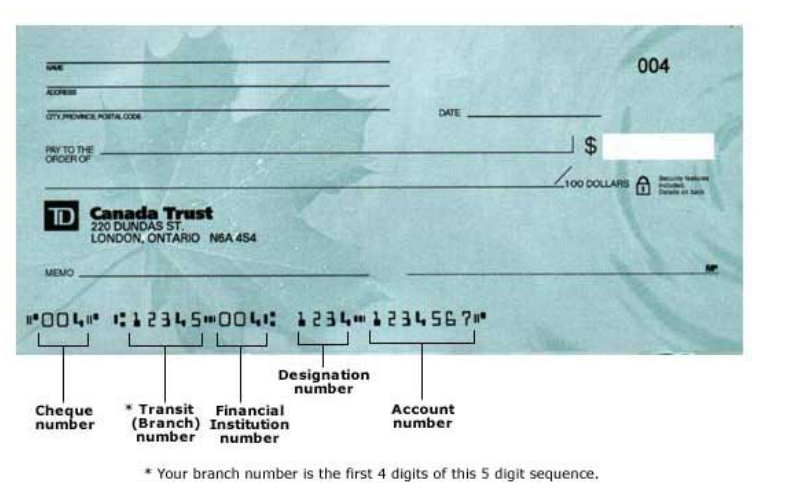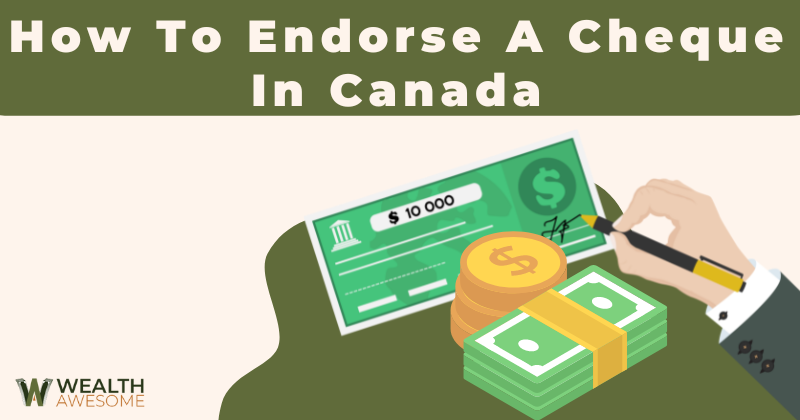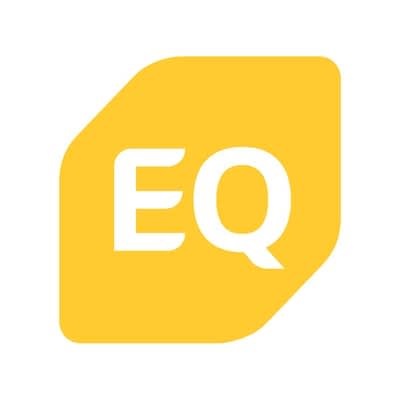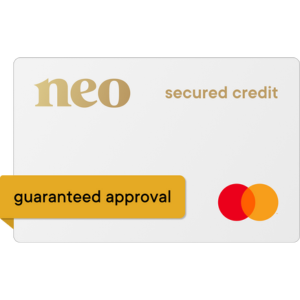Cheques are only used for around 3% of purchases in Canada. However, they’re often used for payroll, bill payments, and financial account verification.
Regardless of how often you use paper cheques, it’s still a good idea to know how to read, write, and endorse one if you’re ever asked to.
Below, I’ll show you exactly how to endorse a cheque in Canada. Almost all Canadian banks require account holders to endorse cheques before they can be deposited, so this is an important step that you should never skip!
Thankfully, endorsing a cheque is incredibly easy. Here’s how.
How To Endorse A Cheque In Canada – Three Steps
Endorsement refers to the act of signing the back of a cheque to transfer the funds to another party. There are a few steps that you should complete before you endorse the cheque and deposit it into your account:
1. Ensure All Details On The Cheque Are Correct
Remember, a cheque represents a legal contract. If there are any errors, it could result in the funds not arriving in your account in a timely manner.
An improperly written cheque could result in delays, your bank calling you to question the funds, or you not receiving the funds at all.
This is why it’s very important to double-check the details written on the front of the cheque before you endorse it. Verify that:
- The “pay to the order of” line has your full name or business name listed
- The written dollar amount doesn’t have any misspelled words
- The numerical dollar amount box has the correct amount written
- The cheque is signed by the individual or organization paying you
- The memo line is filled out to reflect the purpose of the transfer
- The cheque hasn’t already been endorsed by another individual
You should only endorse the cheque once you’re 100% sure that it’s free of errors.
2. Verify & Fix Any Errors That You See
So, what happens if you do find errors on your cheque?
First and foremost, you should NOT endorse or deposit a cheque with erroneous details. If your name is wrong, the amount is incorrect, or the dollar amount box shows a different amount than the written amount line, then you should get these details fixed.
In most cases, cheques that have already been written can’t be “fixed.” Instead, they’ll need to be rewritten by the original issuer. The old cheque should be shredded and destroyed to prevent misuse by potential criminals.
The easiest way to get your cheque fixed is to bring the errors to the other party’s attention. They may ask you to void the cheque, shred the cheque, or mail it back to them.
3. Sign Your Signature On The Endorsement Line
Once you’ve verified that all of the details on the front of the cheque are 100% correct, you can now endorse back of the cheque with your signature, thus providing your agreement to the amount. There should be a section that indicates “endorsement” or “endorse here”
Here, you can choose to either:
- Write your personal signature
- Spell your name out in clear letters
Generally speaking, you’re encouraged to write your personal signature, as this is harder to imitate by would-be thieves and criminals. It proves that it was really you who deposited the cheque, if there are any concerns in the future.
What Is Endorsing A Cheque & Why Does It Matter?
The front of a paper cheque should include all of the important information about the cheque, including:
- What account the money is coming from
- Who is receiving the moneys
- The exact dollar amount to be transferred
- A signature from the sender
- A memo mentioning what the payment is for
These are, by far, the most important details. Without these details, a cheque simply can’t be processed. For a complete breakdown, be sure to check out my guide on how to write a cheque in Canada.
Now, let’s flip the cheque over and take a look at the back side.
The back of cheques should be mostly blank. However, if you look closely, you’ll see a blank line that runs perpendicularly to the rest of the text on the front of the cheque with a small written note, such as “Endorse Here” or “Endorsement.”
The endorsement line of a cheque should be signed by the individual depositing it into their account.
By signing the endorsement line, you are providing your written approval and stating that all of the details on the front of the cheque are valid, including the amount, your name, and other information.
- Note – If the information on the front of the cheque is not valid, then you should not endorse the cheque or attempt to deposit it.
This could result in unwanted problems and complications. Instead, you should return the cheque to the sender and ask them to fix any discrepancies before you endorse it and deposit it into your bank account.
The endorsement also has another purpose – to prevent fraud.
Let’s say that somebody steals a cheque from your chequebook, writes a fraudulent amount on it, and deposits it into their personal bank account (or somebody else’s).
Before they’re allowed to deposit it and receive the funds, they must first endorse it with a signature.
A few days later, when you discover the missing funds from your account, you’ll call your bank’s fraud department and inform them of the situation.
After this, your bank will pull up records of the cheque and closely examine the endorsement line. This will give them some clues as to who fraudulently deposited the cheque and whether or not the signature is real or not.
Do You Have To Endorse A Cheque In Canada?

With so much information on the front of a cheque, it’s often easy to forget to flip the note over and endorse it with your signature.
Sometimes I forget to endorse cheques from time to time, only to have my banker return them to me and ask me to endorse them on the spot.
Legally speaking, all cheques must be endorsed before they can be deposited.
This law applies to paper cheques written in almost every country in the world. If you ever use a cashier’s cheque or money order, you’ll need to endorse these as well to verify them.
Essentially, a cheque represents a legally-binding contract between two parties. One party agrees to pay a specific amount, while the other party verifies the information and provides their signature as a form of written agreement to the contract.
Simply put, a cheque without an endorsement is like a contract that hasn’t been signed. It’s not valid, can’t be cashed, and will be returned.
How To Read Canadian Cheques
Since we’re on the topic, I figured that it’s a good idea to review how to read a cheque in Canada as well.
If you’re not sure how to read a cheque correctly, then verifying a cheque doesn’t make much sense. It’s just like signing a contract that you haven’t read completely. Here’s a quick diagram from a TD Bank cheque, which displays the transit number, financial institution number, designation and account number information:

Accountholder Information (Top Left)
The top left of the cheque should display the name of the individual or organization paying you. It should also display the person or business’ primary mailing address for further verification or if you need to send the cheque back to them.
Date (Top Right)
The date line should include the date when the cheque can be cashed. If you deposit the cheque before the date, the funds typically won’t be transferred to your account until the exact date listed on the cheque.
Payee Information (First Line)
The payee information should include your legal name or business name.
Written Dollar Amount (Second Line)
This line should display the written dollar amount of the cheque.
For example, if $150 is listed in the dollar amount box, this line should read, “One-hundred and fifty dollars and 0/100.” The fraction towards the end represents the cents as a fraction of 100.
Numerical Dollar Amount ($ Box)
This box usually features a ‘$’ sign and should include the exact numerical value of the cheque (i.e., $150.00).
Signature (Bottom Left)
The bottom left of the cheque should be signed by the individual responsible for issuing the cheque to you.
Memo (Bottom Right)
The memo line should include a brief memo describing the purpose of the payment, such as:
- Rent for unit 5A
- Birthday gift
- Payment for invoice #112
In Canada, various types of cheques are used in daily transactions. Here are some of the common types:
Types Of Cheques In Canada To Endorse
Here are all the different types of cheques you might receive and would need to endorse before depositing:
Personal Cheques
Personal cheques are the most common type used by individuals for personal transactions. They are drawn from personal bank accounts. The cheque contains the payer’s (the person writing the cheque) account number, the cheque number, the date, the payee’s name (the person to whom the cheque is payable), and the amount to be paid.
Certified Cheques
A certified cheque is a personal or business cheque that the bank guarantees. The bank verifies that the signature is genuine and that the account has sufficient funds to cover the cheque when it’s issued. These funds are then set aside in the account for when the cheque is cashed.
Money Orders
A money order is a payment order for a pre-specified amount of money. It’s more trusted than a cheque as it is prepaid, meaning that the funds are already paid for and guaranteed by the issuer, usually a post office or a bank.
Bank Drafts
A bank draft is a type of cheque where payment is guaranteed to be available by the issuing bank. When creating a bank draft, the bank takes the money from the payer’s account and then issues the draft.
Business Cheques
Business cheques, or commercial cheques, are used by businesses to pay their obligations. They’re drawn against a business account and usually contain the business name and address.
Traveller’s Cheques
Traveller’s cheques are a secure and convenient way to carry money when travelling. They are preprinted, fixed-amount cheques designed to allow the person signing them to make an unconditional payment to someone else as a result of paying the issuer for that privilege.
Counter Cheques
Counter cheques are drawn on a bank and signed by a cashier or teller. They are often used when someone needs a cheque quickly and does not have a personal cheque at hand. These cheques are guaranteed by the bank.
FAQs About Endorsing A Cheque In Canada
To wrap things up, here are a few brief answers to some of the most commonly asked questions about endorsing a cheque in Canada.
Can You Deposit Somebody Else’s Cheque In Your Account (Canada)?
It all depends on the rules of the bank. Generally speaking, you can deposit somebody else’s cheque into your account. The majority of ABMs won’t notice the difference, as the machines are primarily designed to read the dollar amount box.
However, if you’re depositing the cheque in person, you may encounter some issues. Many banks require the other individual to be present and show their personal ID to sign the cheque to you.
Most cheque-cashing locations also require that the ID matches the name listed on the cheque and cannot cash a cheque that’s not written out to you specifically.
Do I Need To Endorse A Cheque To Deposit It?
Yes, you do. When you endorse a cheque, you’re providing your legal signature and verifying that all of the information on the cheque is correct. A cheque without an endorsement is just like a contract that hasn’t been signed – it’s not valid.
Sometimes, an ABM may take an unendorsed cheque without issues. However, most modern ABMs will spit unendorsed cheques back out.
If you try to deposit an unendorsed cheque in-person, your banker will ask you to endorse it before they allow you to deposit it.
Can I Endorse A Cheque With A Pencil?
You shouldn’t endorse a cheque with a pencil, as pencil writing can be erased and rewritten.
I recommend using a black or blue pen with permanent ink for the best results. This will ensure that the signature is easily detected, even by ABM machines.
What Happens If I Don’t Endorse A Cheque?
Technically speaking, cheques that aren’t endorsed are not valid. While some ABM machines may overlook a cheque that’s not endorsed, most bankers and cheque-cashing locations will return the cheque to you and ask for your endorsement signature.
Do You Have To Endorse A Cheque For e-Deposits?
Online banking apps make it easier than ever to deposit your cheques. All you have to do is upload a photo of the front and back of the cheque, and the amount will be promptly deposited into your bank account.
That being said, you still need to endorse cheques, even if they’re being electronically deposited.
If you upload an image of the back of a cheque without an endorsement signature, your online banking app should display an error message explaining that an endorsement isn’t detected in an image.
Conclusion

Before you try to deposit any cheque that you receive, remember to endorse it! This will ensure that the funds are transferred into your account without any issues, so the cheque isn’t returned.
Are you searching for the best personal bank account?
If so, then keep reading and check out my list of the best no-fee bank accounts in Canada next!





